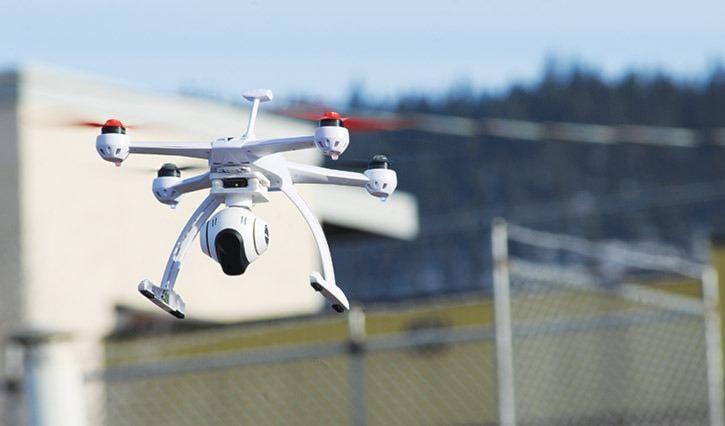The sighting of two large bright red lights flying over Williams Lake last Thursday evening has raised questions around the use of drones.
It isn’t known exactly what Fred and Mary Jane Engstrom saw that night, but speculation is that the lights were from a large drone or unmanned air vehicle.
Mary Jane said she and her husband, Fred, were looking out over the city from their home on Ridgeview Place about 8:35 p.m. Thursday, Feb. 16 when they saw two large round red/amber lights fly from the west over the city, then disappear behind Fox Mountain.
“I wouldn’t have thought anything of it but we both saw them,” Engstrom said, adding that she now wished she had taken a picture of the lights.
They estimated the lights were large and round, about the size of a helicopter cab, and took three to four minutes to move silently over the city.
The lights were travelling about a mile apart at an elevation of about 1,500 feet with one light travelling slightly ahead of the other, Mary Jane said.
Efforts by the Tribune to find out what the lights were by calling Transport Canada, the Williams lake Airport, and the Prince George RCMP have been unsuccessful to this point.
But a media information officer with Transport Canada said she would send an outline of the legal requirements for the operation of drones which is available on their website.
The Transport Canada website advises people to contact their local police department immediately if someone is flying a drone in a way that poses a threat to safety, security, or privacy.
People who think someone is flying a drone in an irresponsible manner without a permit (flying close to other aircraft, near aerodromes, or at a high altitude) and it is not an emergency should complete and submit a Drone incident report form on-line.
People who fill out these new incident report forms that came online in December must be able to clearly identify the flying object in question as a drone, the Transport Canada spokesperson said.
According to the Transport Canada website the Canadian Aviation Regulations people using drones or unmanned air vehicles for work or research are required to apply for a special flight operations certificate so that Transport Canada can ensure operators use their UAV reliably and safely.
This can include restrictions and requirements such as maximum allowed altitude, mandatory communications with air traffic control, and minimum required distances from aerodromes, people, and buildings.
Recreational users do not require an SFOC to fly unless their drone weighs more than 35 kilograms.
However, they should follow Transport Canada’s safety guidelines, including:
• Fly during daylight and in good weather.
• Keep the drone where you can see it with your own eyes — not through an on-board camera, monitor, or smartphone.
• Make sure the drone is safe for flight. Are the batteries fully charged? Is it too cold to fly?
• Respect the privacy of others. Avoid flying over private property or taking photos or videos without permission.
• Don’t fly in clouds or fog.
• Don’t fly closer than nine kilometres from any aerodrome (i.e., any airport, heliport, helipad, or seaplane base).
• Don’t fly higher than 90 metres (300 feet) above the ground.
• Don’t fly closer than 150 metres (500 feet) from people, animals, buildings, structures, or vehicles.
• Don’t fly in populated areas or near large groups of people, including at sporting events, concerts, festivals, or firework shows.
• Don’t fly near moving vehicles, highways, bridges, busy streets, or anywhere you could endanger or distract drivers.
• Don’t fly within restricted and controlled airspace, including near or over military bases, prisons, or forest fires.
• Don’t fly anywhere you may interfere with first responders.
